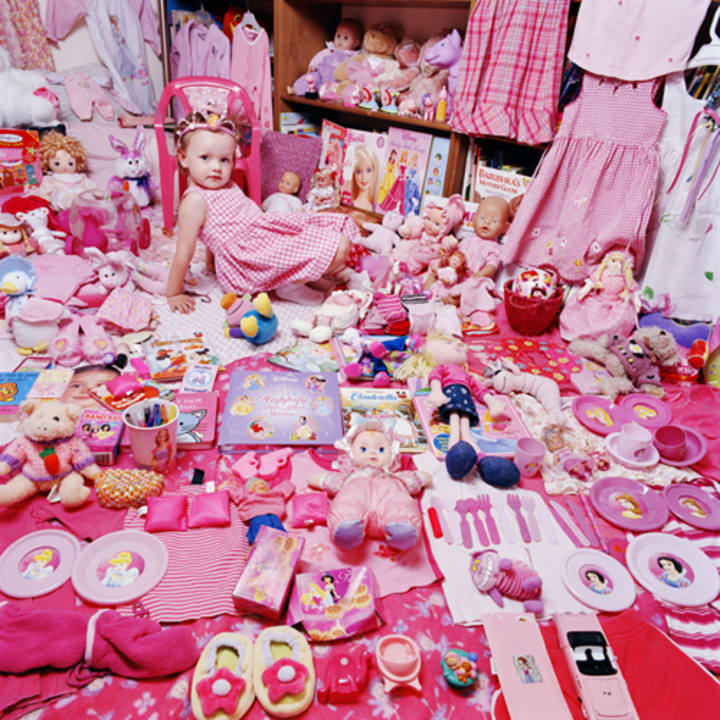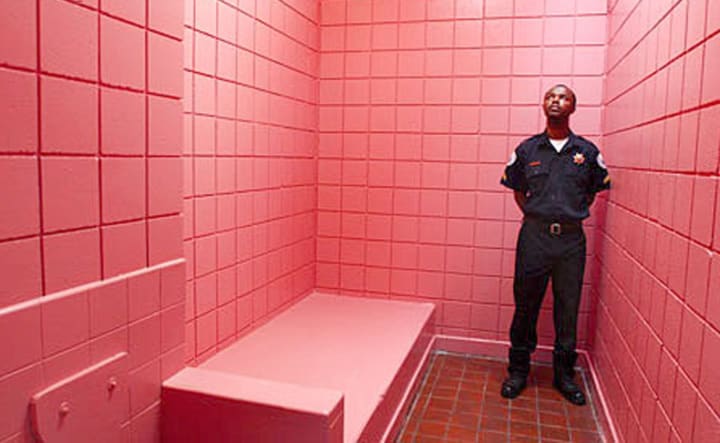BAKER-MILLER PINK: SCIENCE OR SEXISM?
THE HISTORY OF PINK

This is dedicated to anybody who loves pink or hates pink.
In the late 1970s, the United States was in a cultural crisis. Though groundbreaking racial, feminist, sexual, and class movements paved the way for increased equality, rates of drug use and violent crime significantly increased as well. A professor, Alexander G. Schauss, claimed he had a cure: one pint of outdoor semi-gloss red trim paint mixed with one gallon pure white indoor latex paint, otherwise known as P-618, or #FF91AF, or the "pinkest pink" — later, officially named "Baker-Miller Pink." Schauss claimed that this particular shade could calm, lower aggression, and indeed "sap the strength of even the toughest man." You may recognize this color from classic bubblegum or the pepto-bismol pill, but in the 1980s it could be found anywhere; it was a pop culture phenomenon, appearing on bus seats, in the realty market, in drunk tanks, and even in prisons. Schauss' supposedly "proven" hypothesis was that the visual processing of this special color "affect[s] neurological and endocrine functions, which in turn reduce physical strength and thus aggressive behavior." This theory was widely accepted. In fact, the head coach of Iowa State football had Kinnick Stadium's visiting team's locker room painted entirely in the color as an attempt to weaken the other team before big games, leading to a rather strange Western Athletic Conference ruling in the 1990s that home and visiting locker rooms must be painted the same color. People all over believed this color had either supernatural or scientific powers to physically and mentally weaken. But here's the catch — a 1988 study (and several others since then) found zero evidence of a link between the optical processing and visible reactions in exposure to the shade.
So, what's up with Baker-Miller Pink?
Well, Schauss calimed it had to do with visual processing, while I venture it has entirely to do with visual culture. Lisa Cartwright and Marita Sturken once wrote that "nobody is free to look as they please." When people (more accurately, men) saw this color, they weren't just seeing a certain amount of red and white — they were seeing and responding to something with cultural significance. In defamiliarizing the color pink itself, it is revealed that the Baker-Miller pink reaction is not natural but is entirely man-made, and based on sexism.
It is very likely that when you see or think pink, you automatically link it with femininity, whether consciously or not. But this is when the act of defamiliarization is most vital: examining what we would otherwise pass over as common sense. "Things that (to the novice) are apparently automatic, transparent, and natural, are actually symbolic constructions, like a langauge to be learned." Therefore, our understanding of pink as feminine must be constructed in some way — thus it is necessary to understand pink's history on an archeological level in order to validate and/or understand it's association with the feminine.
The pink-for-girls and blue-for-boys binary is not nearly as obvious as you may think. Even the term "pink" is relatively new in color terminology: the first use of it in the Oxford English dictionary as a light red shade was in the late 17th century. And pink only developed its link to females in the 1940s (baby boomers were the first to grow up in a pink-for-girls society). Before the United States even decided on the pink/girls relationship, there was first the death of gender neutral clothing. While androgynous clothing may seem like a fairly recent invention in the West, infants and children for most of history wore white as a matter of practicality (white cotton could be bleached) and both boys and girls wore dresses and sported long hair styles till the age of 6 or 7. Throughout the 1800s, mortality rates rose, so more baby clothing was bought and manufactured. Additionally, clothing and dye production advanced, so colored children's clothing was no longer unreasonable —pink and light blue (the most popular) and other pastel colors entered the market. Pink and blue were mostly used interchangeably for the 19th century, with the exception of some trends that never reached consensus (for example, blue for blondes and pink for brunettes). Just before WWI, manufacturers had a rather genius business idea: by gendering infant items, they could potentially make TWICE as much money — parents would buy all of one color for their first child and repurchase everything in the opposite color when they had a second child of the opposite gender. In 1918, it looked as if the U.S. had finally landed on a color assignment... with pink for boys and blue for girls. The accepted logic behind this choice was that pink was a much stronger color (being a descendent of red, a color much associated with activity, passion and aggression) and was therefore more suitable for boys, while blue belonged to girls because of its delicacy. So, why the switch?
Shortly after, a wealthy man named Henry Huntington made a widely publicized purchase of two 18th century paintings (The Blue Boy and Pinkie) featuring a boy in blue and a girl in pink, leading people to question the assumption they'd made that pink was for boys. In reality, this was because colors were not gendered at the time the paintings were made, but parents in the early 1900s believed these paintings might be proof of a long-lost connection between pink and girls, and blue and boys. And so, while manufacturers kept making items in pink and blue, the stores selling those products characterized them differently; in just New York City, Macy's had pink for girls while Best and Co. advertized it for boys. It legitimately could have gone either way, and it is still not known what ultimately led to the result, but we all know it: pink is for girls.
What this all means is that pink was assigned to girls not because of anything to do with feminity and the color, but because of American capitalism and consumerism.


After the initial female gendering of pink in the 1940s, the meaning of the color pink built more and more significance in society. For instance, second wave feminism (the women's liberation movement of the 1960s and '70s) was overwhelmingly anti-pink, favoring unisex clothing (which in fact leaned more masculine). They rejected the idea of being defined by a color and defined by their gender; they were anti-feminine and thus anti-pink, and in the process further enforced pink's connection to femininity. Women who grew up during this time period rejected the anti-pink agenda by the time they themselves were mothers; they felt they'd missed out, and that it expressed an anti-feminist message that there was something wrong with femininity. So, by the 1990s, there was a renewal of gendered clothing even stronger than before, in proud celebration of pink for girls. Manufacturers pounced on this opportunity making items even more gendered: more things were colored, and baby clothing started featuring objects in addition to the colors in an act of gender-confirming (pink onesies might have a butterfly print while blue ones had lions or footballs). Even today, men wear pink shirts as a statement that they don't conform to gender norms -- of course, all the while further enforcing that pink is the more natural choice for women. All these actions have built off each other and informed our own views of the color pink, whether we are aware of them or not or like them or not. So, when we see pink, we see femininity — regardless of the actual components of the color.
Now, back to Baker-Miller. Alxander Schauss' behavioral photobiological research in the 1970s questioned not only if colors could reflect hormonal changes, but wether colors could cause hormonal changes. He conducted a preliminary strength test of 153 men: he measured the participant's ability to resist the experimenter's pressure applied for as long as possible, while the subject either stared at a deep blue cardboard or a bright pink one. All but two of teh men who recieved a pink card performed weaker than the average. He then used a dynamometer (a more accurate measure of strength) to test the squeeze strength of 38 more men, yielding the same results. On March 1st, 1979, the U.S. Naval Correctional Center in Seattle, Washington painted their holding cells in the color as part of the experiment (the two men who agreed to do so: Gene Baker and Ron Miller, hence the color's name). Inmate violence and hostility had been a huge problem, but for 156 days after installation of the pink there wasn't a single incident. Similar results were soon shown at the Kuiper Youth Center in San Bernardino. One particularly violent youth in this facility, known for extreme verbal and physical aggression for several months (including during the numerous times he was placed in an isolation room, one of in which he was aggressive for a full six hours during) was placed in the pink room in a state of rage, and in six minutes was found sitting in the middle of the room crying. For over 1.5 months after that short placement, he didn't revert to his aggressive ways. According to Dr. Boccumini, in exposure to Baker-Miller pink, "he was literally stripped down to his real psychological state, expressing his underlying frustration and depression."

What triggers this effect? Well, the 1988 study previously mentioned confirmed it was not biological. What Schauss inadvertantly did prove was that the culturally constructed meanings behind colors are so strong as to invoke a physical reaction, so immediate that they could pass as natural. The paint itself did not trigger men to be weaker, but "being placed in a pink detention cell... attack[ed] the inmates perceived manhood and/or cause feelings of humiliation." The identification of pink with femininity is so ingrained in these men's brains, it emasculated them to see it — since they conceive of masculinity as strong and femininity as weak. The Baker-Miller Pink phenomenon is caused by two things, neither of which are biological: pink's synonimity with femininity due to capitalism (the desire to sell more children's clothing) and the long-held sexist belief that females are weaker, making femininity syonymous with weakness — and weakness synonymous with pink. All in all, Schauss' experiments proved the power of visual culture over biological vision.
SOURCES
"Baker-Miller Pink" by Bob Hambly, Colourstudies.com, 2017.
"The Case Against Kinnick's Pink Locker Room" by Kembrew McLeod, Des Moines Register, 2014.
"The Complicated Gender History of Pink" by Puja Bhattacharjee, CNN, 2018.
"An Introduction to Visual Culture" in Practices of Looking by Lisa Cartwright and Marita Sturken, Oxford University Press, 2017.
On Color by David Scott Kastan with Steven Farthing, Yale University Press, 2018.
"The Psychiological Effect of Color on the Supression of Human Aggression: Research on Baker-Miller Pink" by Alexander G. Schauss, International Journal of Biosocial Research, 1985.
The Secret Lives of Color by Kassia St. Clair, Penguin Random House LLC, 2016.
"When Did Girls Start Wearing Pink?" by Jeanne Maglaty, Smithsonian Magazine, 2011.
About the Creator
Lili Price
Lili is an artist/photographer based in San Francisco and NYC, studying at the Parsons School of Design. She teaches Modern Art history with an emphasis on female artists, and is an art college application advisor.
lilipriceportfolio.com






Comments
There are no comments for this story
Be the first to respond and start the conversation.